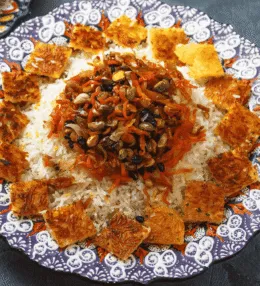
- View
Table of Contents
ToggleYomari is more than just a sweet dumpling from Nepal. It is a symbol of warmth, celebration and community, especially for the Newar people of the Kathmandu Valley. Traditionally made during Yomari Punhi, this steamed treat marks the end of the rice harvest and carries a sense of ritual and joy with each bite.
Though deeply rooted in cultural tradition, Yomari has also found its way into the everyday Nepali kitchen. It is served not only during festivals but also as a special homemade snack when family or guests gather. Its distinct shape, soft rice shell and rich filling make it instantly recognisable and deeply comforting.
Want to dive deeper into Nepalese Cuisine? Don’t miss our post on 15 Traditional Nepalese Foods to Try
What Is Yomari?
Yomari is a steamed dumpling made with rice flour and filled with a sweet mixture, typically made from jaggery and sesame seeds. The dough is shaped into a teardrop or fish like form before being steamed, which gives the dumpling its signature texture and look.
The word ‘Yomari’ is derived from Nepal Bhasa, where ‘yo’ means ‘favourite’ and ‘mari’ means ‘bread’ or ‘delicacy’. The name itself tells you everything you need to know. For many, it is a treasured treat that brings back memories of family kitchens and warm, festive nights.
Ingredients and Taste
The dough is made from freshly ground rice flour, kneaded with warm water until smooth and pliable. It is then shaped by hand, carefully pressed into the familiar tapered form, ready to be filled. Making Yomari requires both patience and skill, often passed down through generations.
The filling is what gives Yomari its soul. A mix of dark jaggery and toasted sesame seeds melts into a sweet, nutty centre that balances perfectly against the gentle chew of the rice casing. Some versions include chaku, a hardened molasses that turns deliciously gooey when steamed.
When eaten warm, the first bite yields to a soft, elastic outer layer that gives way to a molten, earthy sweetness inside. The sesame adds texture, while the jaggery delivers a deep caramel note. It is simple in its components but layered in flavour and meaning.
A Taste of History
Yomari is said to have originated among the Newar community of Nepal, where it is closely linked to the Yomari Punhi festival. Held on the full moon of December, the event celebrates the end of the rice harvest and the beginning of the winter season.
According to legend, a couple in ancient times offered Yomari to a passing sage. In return, the sage blessed them with prosperity, and so the dish came to be associated with good fortune. This story still lives on, carried through each steaming batch of dumplings made in Nepali homes.
Though deeply tied to Newar traditions, Yomari has gradually become a favourite across Nepal. Its unique preparation and seasonal importance make it more than just a dessert. It is a reflection of heritage, a celebration of abundance, and a heartfelt offering of warmth.
To taste Yomari is to experience a piece of Nepali culture at its most sincere. From its origins in the Kathmandu Valley to the hands of home cooks across the country, this humble dumpling continues to hold its place as one of Nepal’s most cherished culinary treasures.
How to Make Yomari (Stuffed Rice Dumpling)
Yomari is a cherished Nepalese delicacy from the Newar community, traditionally prepared during the Yomari Punhi festival to celebrate the harvest. These steamed rice flour dumplings are filled with rich molasses and sesame seeds, creating a comforting sweetness wrapped in soft, fragrant dough. The process requires patience and gentle hands, but the result is deeply satisfying. See the recipe card at the bottom for printable directions
Ingredients
- 200 g rice flour (preferably fine ground)
- 200 ml hot water
- 1 tbsp ghee (clarified butter)
- 100 g jaggery (or dark molasses)
- 50 g sesame seeds
- 1 tbsp grated coconut (optional, for added texture)
- A pinch of salt
- Banana leaves or parchment paper for steaming (optional, for lining)
Cooking Instructions
Step 1: Prepare the rice dough
In a large bowl, mix the rice flour and a pinch of salt. Gradually pour in the hot water, stirring continuously with a wooden spoon until it forms a sticky dough. Once cool enough to handle, knead until smooth and pliable. Add a teaspoon of ghee to prevent sticking. Cover with a damp cloth and set aside.
Step 2: Toast the sesame seeds
In a dry pan over medium heat, lightly toast the sesame seeds until fragrant and golden. This enhances their nutty flavour. Remove from heat and allow to cool slightly before grinding coarsely with a mortar and pestle.
Step 3: Prepare the filling
In a small pan, melt the jaggery over low heat until it becomes syrupy. Stir in the ground sesame seeds and grated coconut (if using). Mix well to form a thick, sticky paste, then set aside to cool.
Step 4: Shape the dough
Divide the rice dough into equal portions, about the size of a golf ball. Roll each portion between your palms to smooth it out. Keep the dough covered with a damp cloth to prevent drying.
Step 5: Form the dumplings
Take one dough ball and gently shape it into a cone using your fingers. Carefully hollow out the centre by pressing your thumb inside, forming a thin-walled pocket.
Step 6: Add the filling
Spoon a small amount of the sesame-jaggery filling into the hollow centre, taking care not to overfill. Seal the top by pinching and shaping the dough to close it neatly, forming a pointed tip.
Step 7: Continue shaping
Repeat with the remaining dough and filling. If the dough becomes sticky, lightly grease your fingers with ghee. Place the shaped yomaris on a tray lined with banana leaves or parchment.
Step 8: Steam the yomari
Set up a steamer and bring water to a gentle boil. Arrange the yomaris in a single layer, leaving space between them. Steam for about 10–12 minutes until the dumpling skin turns slightly translucent and firm to the touch.
Step 9: Check doneness
Test one yomari by cutting slightly at the base; the dough should be soft and cooked through, with the filling melted and aromatic. Steam a few minutes longer if needed.
Step 10: Serve and enjoy
Serve warm, brushed lightly with ghee if desired. Yomari is best enjoyed fresh, accompanied by a cup of tea. The texture is delightfully soft, with the rich, sweet filling offering a beautiful contrast.
Variations and Substitutions
- Filling variation: Replace jaggery with brown sugar if unavailable. Add crushed peanuts or walnuts for extra crunch.
- Coconut option: Fresh or desiccated coconut can be used depending on preference.
- Rice flour substitute: Glutinous rice flour can be used for a slightly stickier texture, though traditional yomari uses regular fine rice flour.
- Flavour enhancement: A pinch of cardamom powder adds warmth and aroma to the filling.
Cooking Tips for Perfect Yomari
- Always use hot water when preparing the dough for smooth, flexible texture.
- Knead well to avoid cracks when shaping.
- Keep dough covered with a damp cloth to prevent drying.
- Seal the tops tightly to stop the filling from leaking during steaming.
- Avoid over-steaming, as it can make the outer layer tough.

Nepali Yomari (Stuffed Rice Dumpling)
Ingredients
- 200 g rice flour preferably fine ground
- 200 ml hot water
- 1 tbsp ghee clarified butter
- 100 g jaggery or dark molasses
- 50 g sesame seeds
- 1 tbsp grated coconut optional, for added texture
- A pinch of salt
- Banana leaves or parchment paper for steaming optional, for lining
Instructions
- In a large bowl, mix the rice flour and a pinch of salt. Gradually pour in the hot water, stirring continuously with a wooden spoon until it forms a sticky dough. Once cool enough to handle, knead until smooth and pliable. Add a teaspoon of ghee to prevent sticking. Cover with a damp cloth and set aside.
- In a dry pan over medium heat, lightly toast the sesame seeds until fragrant and golden. This enhances their nutty flavour. Remove from heat and allow to cool slightly before grinding coarsely with a mortar and pestle.
- In a small pan, melt the jaggery over low heat until it becomes syrupy. Stir in the ground sesame seeds and grated coconut (if using). Mix well to form a thick, sticky paste, then set aside to cool.
- Divide the rice dough into equal portions, about the size of a golf ball. Roll each portion between your palms to smooth it out. Keep the dough covered with a damp cloth to prevent drying.
- Take one dough ball and gently shape it into a cone using your fingers. Carefully hollow out the centre by pressing your thumb inside, forming a thin-walled pocket.
- Spoon a small amount of the sesame-jaggery filling into the hollow centre, taking care not to overfill. Seal the top by pinching and shaping the dough to close it neatly, forming a pointed tip.
- Repeat with the remaining dough and filling. If the dough becomes sticky, lightly grease your fingers with ghee. Place the shaped yomaris on a tray lined with banana leaves or parchment.
- Set up a steamer and bring water to a gentle boil. Arrange the yomaris in a single layer, leaving space between them. Steam for about 10–12 minutes until the dumpling skin turns slightly translucent and firm to the touch.
- Test one yomari by cutting slightly at the base; the dough should be soft and cooked through, with the filling melted and aromatic. Steam a few minutes longer if needed.
- Serve warm, brushed lightly with ghee if desired. Yomari is best enjoyed fresh, accompanied by a cup of tea. The texture is delightfully soft, with the rich, sweet filling offering a beautiful contrast.
Nutrition
You May Also Like







Leave a Review